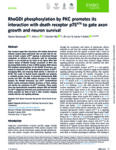In our latest paper, we report that the sensitivity of fat cells to signals that increase the breakdown of fat is linked to the receptor ALK7. The discovery, which is published today in eLife, suggests that ALK7 is an interesting target for future strategies to treat obesity.
The ALK7 receptor is predominantly found in fat cells and tissues involved in controlling the metabolism. Intriguingly, mice with a mutation in ALK7 accumulate less fat than mice with a functional version of the protein. Until now, it has not been known why.
We created mice whose fat cells lack ALK7, but whose other cells all produce ALK7 as normal. We found that fat cells lacking the ALK7 receptor are more sensitive to adrenaline and noradrenaline signals, a finding that can explain why they accumulate less fat even though the mice were on a high-fat diet. Adrenaline and noradrenaline are central players in metabolism. These hormones trigger the burst of energy and increase in heart rate and blood pressure that are needed for the “fight-or-flight” response. The hormones normally stimulate the breakdown of fat, but when nutrients are plentiful, fat cells become resistant to this signal and instead store fat. This mechanism evolved to facilitate energy storage during times of abundant food supply, enhancing survival upon starvation. In the industrialized world where food is constantly accessible, this resistance can cause an unhealthy increase in body fat and result in obesity.
We then investigated if it is possible to prevent obesity by blocking ALK7. At present, there are no known ALK7 inhibitors, but we solved this by generating mice with a special mutation in ALK7 which renders it sensitive to inhibition by a chemical substance. This made it possible for us to block the receptor at any time in an otherwise normal adult animal.
– Using this approach, we could get these mice to be leaner on a high fat diet simply by administration of the chemical. This suggests that acute inhibition of the ALK7 receptor can prevent obesity in adult animals, says Tingqing Guo, first author of the study.
We have also showed that the ALK7 receptor works in a similar way in human fat cells as it does in mice.
– Overall, these results suggest that blockade of the ALK7 receptor could represent a novel strategy to combat human obesity, says Carlos Ibanez, principal investigator of the study.
The work was supported by grants from the European Research Council, Swedish Research Council, Strategic Research Program in Diabetes of Karolinska Institutet, Swedish Cancer Society, Knut and Alice Wallenberg Foundation, the National University of Singapore and the National Medical Research Council of Singapore. eLife is a peer-reviewed open-access scientific journal established at the end of 2012 by Nobel Prize Winner Randy Schekman, with support from the Howard Hughes Medical Institute, Max Planck Society and Wellcome Trust.
The paper is freely accessible and can be found HERE.


